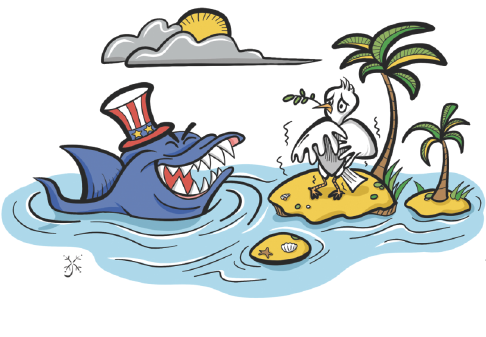Navigation freedom no excuse for interference
Updated: 2016-03-10 08:41
By LIU HAIYANG(China Daily)
|
||||||||

The United States was back again in the South China Sea recently, this time with a muscle-flexing navy fleet in a greater show of strength. The US Navy John C. Stennis strike group exited the South China Sea on March 6 after six days of debut "routine operations" since its regularly scheduled deployment began Jan 15, putting the Asia-Pacific region on high alert and leaving many wondering what are the signals behind the move and what impact it will have on regional peace and stability.
The first striking point about the US military deployment is that it was accompanied by an unusually high-profile media coverage. Unlike the previous nearly unnoticed mission, the US Navy spokesperson, unnamed military officials and military experts have released a wave of information both before and after the operation. The carefully designed media coverage apparently shows the US wanted its "operation" to be trumpeted so that it could enhance the perception of its military presence in the region.
Another sensitive issue is the timing of the US operation. Tensions have been rising since the US military sent its vessels close to and flew its aircraft over China's islands in the South China Sea. Now, the deployment of a US aircraft carrier and escort ships-seemingly because, as the US claims, "China is militarizing the region to guard its excessive territorial claims"-will heighten the tensions. An aircraft carrier entering regional waters without any reason certainly cannot have peaceful intentions.
Sticking to its stance on its previous maneuvers in the South China Sea, the US has also emphasized that the new operation is routine. The US has claimed its ships and aircraft have been operating freely for decades in the Western Pacific-including the South China Sea. But that does not sound convincing.
It is true that the US has long maintained a strong military presence in the region. But now it is in the process of deploying 60 percent of its warships and military aircraft in the Asia-Pacific as part of its "pivot to Asia" policy, which could seriously affect the regional balance of power.
- Global health entering new era: WHO chief
- Brazil's planning minister steps aside after recordings revelation
- Vietnam, US adopt joint statement on advancing comprehensive partnership
- European border closures 'inhumane': UN refugee agency
- Japan's foreign minister calls A-bombings extremely regrettable
- Fukushima impact unprecedented for oceans: US expert

 Stars of Lijiang River: Elderly brothers with white beards
Stars of Lijiang River: Elderly brothers with white beards
 Wealthy Chinese children paying money to learn British manners
Wealthy Chinese children paying money to learn British manners
 Military-style wedding: Fighter jets, grooms in dashing uniforms
Military-style wedding: Fighter jets, grooms in dashing uniforms
 Striking photos around the world: May 16 - May 22
Striking photos around the world: May 16 - May 22
 Robots help elderly in nursing home in east China
Robots help elderly in nursing home in east China
 Hanging in the air: Chongqing holds rescue drill
Hanging in the air: Chongqing holds rescue drill
 2.1-ton tofu finishes in two hours in central China
2.1-ton tofu finishes in two hours in central China
 Six things you may not know about Grain Buds
Six things you may not know about Grain Buds
Most Viewed
Editor's Picks

|

|

|

|

|

|
Today's Top News
Liang avoids jail in shooting death
China's finance minister addresses ratings downgrade
Duke alumni visit Chinese Embassy
Marriott unlikely to top Anbang offer for Starwood: Observers
Chinese biopharma debuts on Nasdaq
What ends Jeb Bush's White House hopes
Investigation for Nicolas's campaign
Will US-ASEAN meeting be good for region?
US Weekly

|

|







